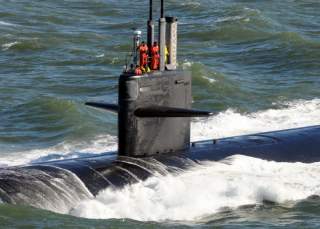Is America's Dominance Below the Seas Coming to an End?
"The last 25 years of unrivalled U.S. undersea dominance may be coming to an end unless U.S. forces adapt to the changing undersea operating environment."
- New basis for the submarine-ASW competition: The effectiveness of traditional passive sonar will continue to erode as rival submarines become quieter, their stealth is enhanced with acoustic counter-detection systems, and as competitors deploy more unmanned systems that radiate little noise. The detection method for 21st century ASW may be low-frequency active sonar, non-acoustic detection, or some other previously unexploited technique enabled by ongoing technological advances.
- The advent of undersea “battle networks.”: New long-range sensors and emerging undersea communication capabilities may enable undersea fire control networks analogous to those that use radio signals above the surface of the water. Undersea networks could also enable coordinated surveillance or attack operations by swarms of UUVs operating autonomously or controlled from a manned submarine or other manned platform.
- A new (old) ASW approach. Aa described above, in all three 20th-century conflicts U.S. forces eventually adopted an ASW concept that emphasized preventing enemy submarines from being effective rather than sinking them–an approach that exploits the inherent disadvantages of undersea platforms. U.S. forces will likely have to take a similar tack to counter growing adversary undersea forces.
- A new approach to offensive undersea operations: Submarines will increasingly need to shift from being front-line tactical platforms like aircraft to being host and coordination platforms like aircraft carriers. Large UUVs and other deployed systems that are smaller and less detectable will increasingly be used instead of manned submarines for tactical missions such as coastal intelligence gathering, land attack, or anti-ship missions.
- Expansion of undersea infrastructure. The sea floor supports rapidly growing oil and mineral extraction equipment and pipelines, communication transmission cables, power generation equipment, and acoustic and non-acoustic sensors. An undersea warfare approach will have to address the threat of inadvertent detection by non-military sensors, protection of friendly infrastructure, and opportunities to damage enemy infrastructure during a conflict.
The coming era in undersea competition will require a significant rethinking of how military forces conduct undersea warfare. These new operational approaches will have significant implications for the kinds of undersea capabilities that should be developed, and how the larger naval and joint force should evolve to complement them. In particular, a new family of undersea vehicles and systems is needed to reduce the growing vulnerability of today’s principal undersea platform, the manned submarine. If the United States does not begin this assessment and shift its R&D investment, it could fall behind rivals who will “steal a march” in the undersea domain.
Bryan Clark is a Senior Fellow at the Center for Strategic and Budgetary Assessments (CSBA).
Image: Flickr/Official U.S. Navy/CC by 2.0

